Amorpha juglandis
Amorpha juglandis
uh-MOOR-fuhmmjug-LAN-dis
(J. E. Smith, 1797)
Sphinx
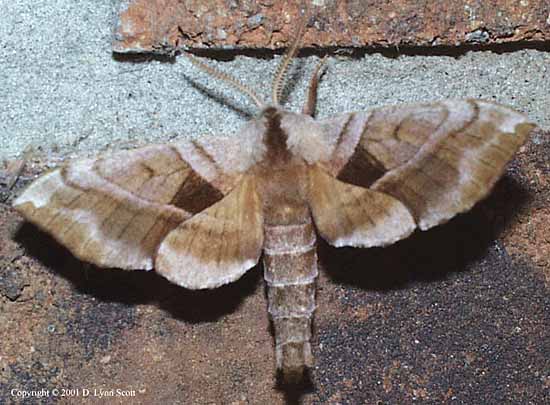
Cressonia juglandis male courtesy of Lynn Scott.
This site has been created by
Bill Oehlke at oehlkew@islandtelecom.com
Comments, suggestions and/or additional information are welcomed by
Bill.
|
TAXONOMY:
Superfamily: Sphingoidea, Dyar, 1902
Family: Sphingidae, Latreille, 1802
Subfamily: Smerinthinae, Grote & Robinson, 1865
Tribe: Smerinthini, Grote & Robinson, 1865
Genus: Amorpha, Hubner, [1809]
Species: juglandis, (J. E. Smith, 1797) |
MIDI MUSIC
"What.A.Wonderful.World"
copyright C. Odenkirk
MIDI CITY
ON.OFF
<bgsound src="world.mid" LOOP=FOREVER>
|
DISTRIBUTION:
Amorpha and Cressonia
and Laothoe are often used as the genus name for this species.
The Amorpha juglandis moth (wingspan 45-75 mm; males smaller than females) flies from Maine south to
Florida, west to North Dakota and west Texas, and south to Nuevo Leon, Mexico.
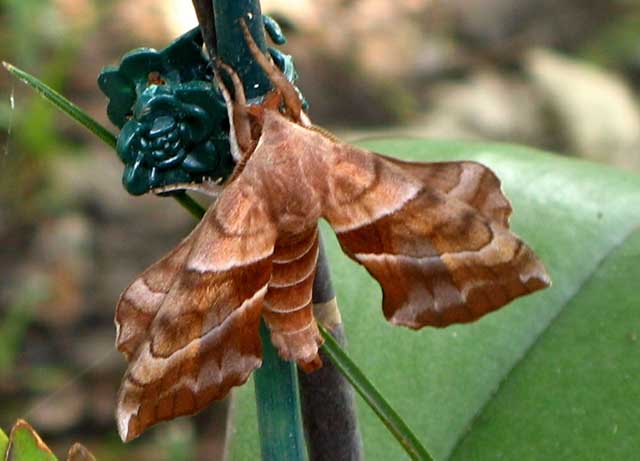
Amorpha juglandis, Port Neches, Jefferson County, Texas,
May 9, 2009, courtesy of Linda Williams.
The populations of Amorpha juglandis in western Ontario are the reportedly birch-feeding subspecies
manitobae
according to Riotte.
This species is also know as the Walnut sphinx, (Laothoe juglandis). Typical of species within the
Smerinthini tribe, these moths do not feed as adults.
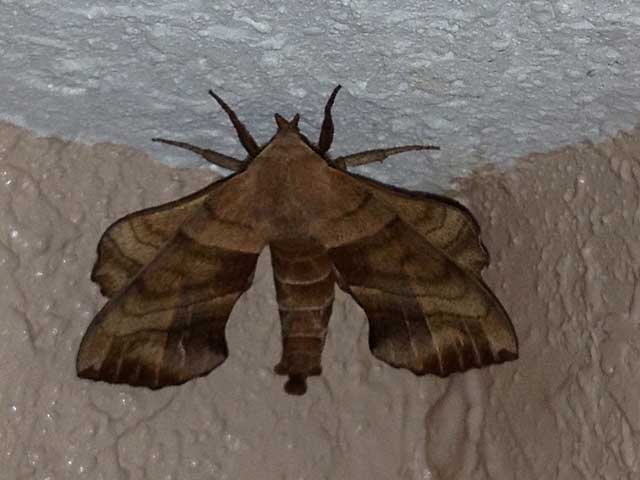
Amorpha juglandis, Salada, Bell County, Texas,
September 12, 2012, courtesy of Fred Colwell.
The adults are also highly variable; sometimes wings of an
individual may be all one color or may have several colors, ranging from pale to dark brown, and may have a white or
pink tinge. Patterns range from faint to pronounced.
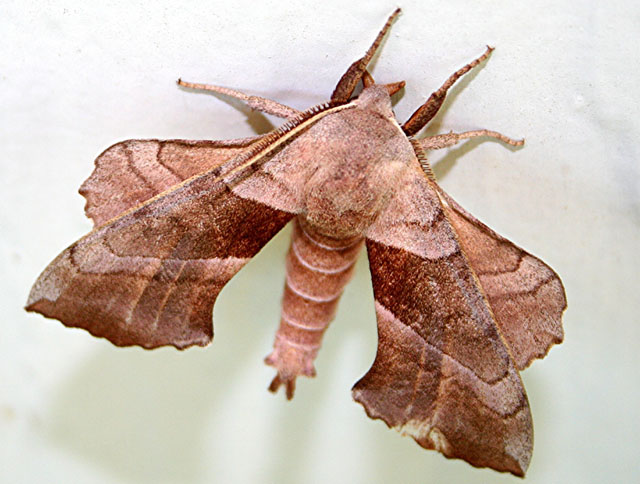
Amorpha juglandis, Arlington (Tarrant County), Texas,
April 19, 2006, courtesy of Dale Smith.
Visit Amorpha juglandis, Searcy County, Arkansas, April 4, 2012, Marvin Smith
Visit Amorpha juglandis, Shreveport, Caddo Parish, Louisiana, Rosemary Seidler.
Visit Amorpha juglandis female, Eddie Jones Park, Shreveport, April 15, 2013, courtesy of Jeff Trahan.
Visit Amorpha juglandis, Priddy, Mills County, May 12, 2014, Melinda Adams.
Visit Amorpha juglandis, MV light on small building on County Hwy R18, Boone County, Iowa,
June 23, 2009, Thomas Jantscher.
Visit Amorpha juglandis male,
Londonderry, Rockingham, New Hampshire, June 28, 2006, courtesy of Deb Lievens.
Visit Amorpha juglandis female, Waubonsie S.P., Fremont County, Iowa, July 5, 2013; Thomas Jantscher
Visit Amorpha juglandis, Big Spring, Howard County, Texas, September 17, 2013, Jay Phinney.
FLIGHT TIMES AND PREFERRED FOOD PLANTS:Amorpha
juglandis adults fly from May-August in the northern part of
their range, and as at least four broods in Louisiana from
March-October.
Amorpha juglandis larvae feed upon Walnut and butternut
(Juglans), hickory (Carya), alder (Alnus),
beech (Fagus), hazelnut (Corylus), and hop-hornbeam
(Ostrya).
Amorpha juglandis male, May 17-18, 2006, Peterborough, Ontario, courtesy
of Tim Dyson. View additional Amorpha juglandis
by Tim. Visit Amorpha juglandis
courtesy of Alison Sklarczyk. |
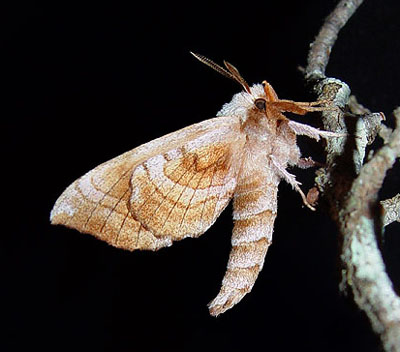 |
ECLOSION, SCENTING AND MATING:
Moths emerge from subterranean pupae.
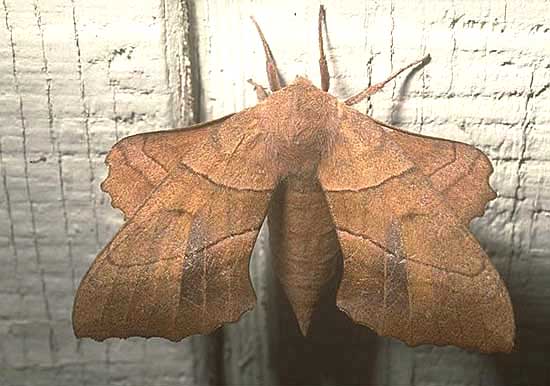
Amorpha juglandis female courtesy by Drees.
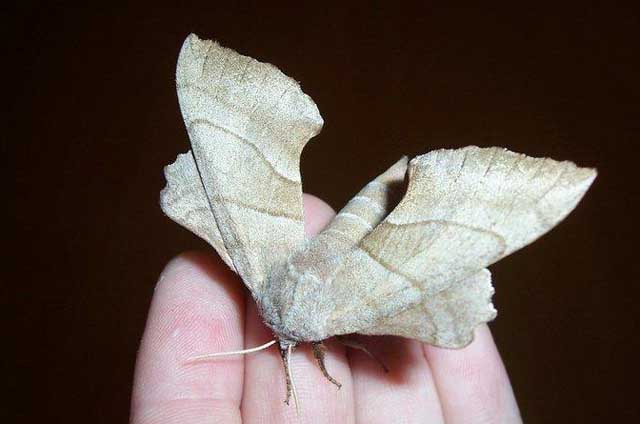
Amorpha juglandis female,
Navarro County, Texas, courtesy of Lacey L. Ogburn.
After emerging from her subterranean chamber, the female will usually climb to hang and inflate her wings properly.
At night, before her first flight, she will extend a scent gland from the tip of her abdomen. The gland releases a pheromone into the night
sky, and males, flying into the wind in a zig zag fashion, are able to detect the scent, via their antennae, and locate the female.
The moths will often remain "in copula" (paired) until the following evening. The male will fly off in search of another female, and the
female will fly off to deposit her green eggs, as many as 200-300 of them (note her swollen abdomen, below).
Ashley Tarleton sends the following image from Houston Texas.
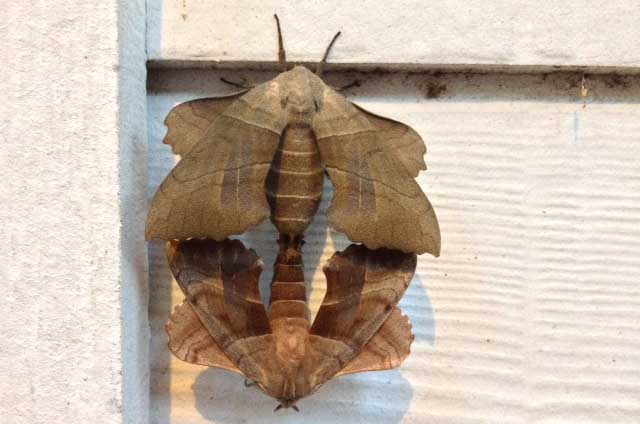
Amorpha juglandis in copula, Houston, Texas,
July 1, 2014, courtesy of Ashley Tarleton.
This species has no mouth parts and no feeding tube. It does not eat in its adult stage, and usually exists as an adult moth for only about a week, just long
enough for mating and dispersal of eggs. The moths get their energy for flight from fats stored during their feeding stage as larvae (caterpillars).
EGGS, LARVAE AND PUPAE:
Caterpillars make a squeaking sound when
disturbed.
This is one of the first Sphingidae I reared as a boy.I fed them on hop-hornbeam in a sleeve by our
backyard pond/river in New Jersey. I wasn't ready for them when they reached maturity and didn't know they would pupate
in a bucket under loose paper towelling. |
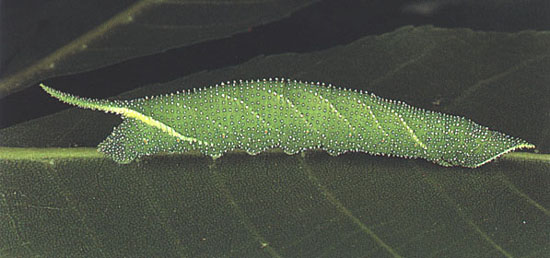 |
Seana Saxon sends these nice images from Dallas, Texas, August 3,
2006. The pointed head (outlined in yellow), grainy skin and dominant last abdominal stripe
are diagnostic.
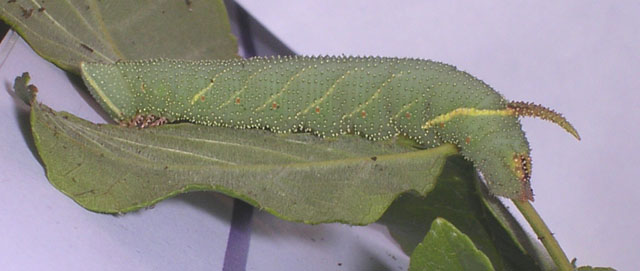
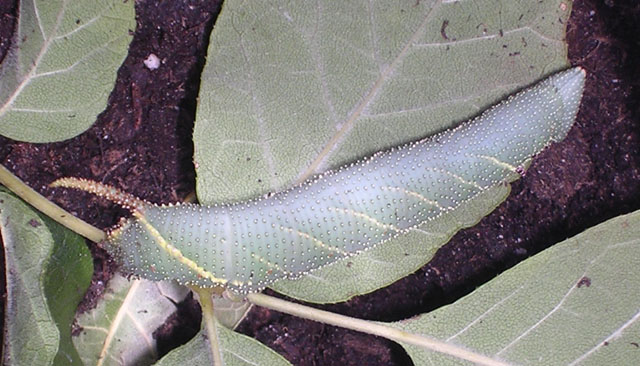
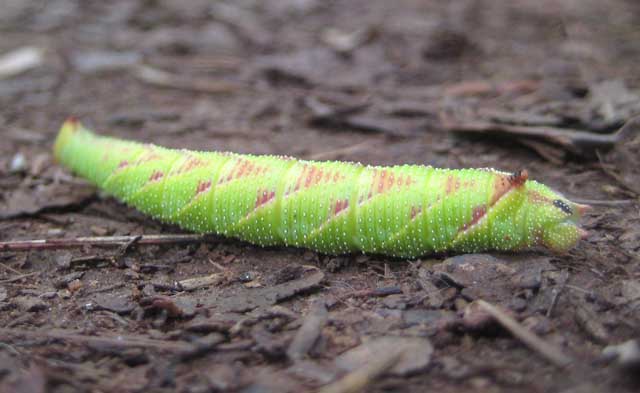
Amorpha juglandis fifth instar, Guilford County, North Carolina,
October 2009, courtesy of Susie Bell, her daughter Adrienne, and Isaac Savage.
Susie sent me the image of the Amorpha juglandis image posted above.
It had been forwarded to her by her daughter for identification, with the actual image taken by Isaac Savage.
Usually Amorpha juglandis larvae are without the red patches, but the red markings can occur to varying degrees. More consistent characters for this species are the
raised whitish dots in regular rings around the girth, the pointed head capsule and the two small protuberances, one on the upper outer edge of each anal claspers.
There are seven diagonal lines with the one extending to the anal horn being the most pronounced.
Joe Garris from Stillwater, Sussex County, New Jersey, reports, "I found an Amorpha juglandis larva on shag-bark hickory and in a few days it went prepupal
and is now down in the peat. I expect it will overwinter."
Visit Amorpha juglandis, Austin, May 13, 2010,
courtesy of Suvi Aika.
Larval Food Plants
Listed below are primary food plant(s) and alternate food plants. It is hoped that this
alphabetical listing followed by the common name of the foodplant will
prove useful. The list is not exhaustive. Experimenting with closely
related foodplants is worthwhile.
Alnus
Carya
Corylus.......
Fagus
Juglans
Ostrya
|
Alder
Hickory
Hazelnut
Beech
Walnut and Butternut
Hop-hornbeam
|
Return to U. S. A. Table
Return to Main Sphingidae Index
Return to Smerinthini Tribe
Enjoy some of nature's wonderments, giant silk moth cocoons.
These cocoons are for sale winter and fall. Beautiful Saturniidae moths will emerge the following spring and summer.
Read Actias luna rearing article. Additional online help available.
Use your browser "Back" button to return to the previous page.
This page is brought to you by
Bill Oehlke and the
WLSS. Pages are on space rented from Bizland. If you would like
to become a "Patron of the Sphingidae Site", contact Bill.
Please send sightings/images to Bill. I will do my best to respond to
requests for identification help.
 | 
Show appreciation for this site by clicking on flashing butterfly to the left.
The link will take you to a page with links to many insect sites. |
This website has been created and is maintained by Bill Oehlke without government or institutional financial assistance. All expenses, ie., text reference
support material, webspace rental from Bizland, computer repairs/replacements, backups systems, software for image adjustments (Adobe Photoshop; L-View),
ftp software, anti-virus protection, scanner, etc. are my own.
I very much appreciate all the many images that have been sent to me, or of which I have been granted permission to copy and post from other websites.
All images on this site remain the property of respective photographers.
If you would like to contribute to the maintenace of this website by sending a contribution to
Bill Oehlke
Box 476
155 Peardon Road
Montague, Prince Edward Island, C0A1R0
Canada
your donation would be much appreciated and would be used for
1) paying for webspace rental;
2) paying for computer maintenance and software upgrades;
3) purchases of additional text reference material (journals and books) in anticipation of expanding the site to a worldwide Sphingidae site;
4) helping to pay my daughter's tuition (completed spring 2013); with anything left over going to humanitarian aid.
If you are mailing a check from USA, please use $1.10 (2013 rate) postage. Donations can also be made through Paypal via the button below.













